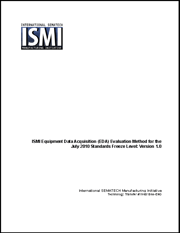Over the past several months, we have posted a number of blogs dealing with the testing of SEMI’s Equipment Data Acquisition (EDA / aka Interface A) standards suite. The first of these posts connected the importance of this topic to the increased adoption of the EDA standards across the industry, and broke the overall problem domain into its three major components.
Subsequent postings provided additional detail in each of these areas:![]()
-
Compliance testing – does the equipment adhere to the specifications described in the SEMI Standards?
-
Performance and stability testing– does the equipment meet the end users’ performance and availability specifications?
-
Equipment metadata model conformance testing – does the equipment model delivered with the interface represent the tool structure and content anticipated by the end customer?
To bring this series to a close, this post addresses the “as-is” state of EDA testing as it is practiced today by the advanced semiconductor manufacturers who are requiring EDA interfaces on new equipment purchases and the suppliers who provide that equipment.
For compliance testing, the three options in general use include:
-
ECCE Plus product- this software tool was originally developed under contract with the International Sematech Manufacturing Initiative (ISMI) to validate the fidelity, usability, and interoperability of early versions of the standard; it can used to manually execute a set of procedures documented in the “ISMI Equipment Data Acquisition (EDA) Evaluation Method for the July 2010 Standards Freeze Level: Version 1.0” document (see title page below) to exercise most of the capabilities called for in the standard; note that this is the only commercially available solution among the three.

-
Company-specific test suites – one major chip manufacturer (and early adopter of EDA) maintains its own partially-automated set of compliance tests, and provides this system to its equipment suppliers as a pre-shipment test vehicle. This set of tests is then used in the fab as part of the tool acceptance process; however, this system also includes a number of company-specific automation scenarios, which are not available for outside use. This highlights the need to support custom extensions in an industry-validated tester if it is to be commercially viable.
-
In-house custom test clients – this is a variation of #2 that some of the major OEMs have chosen as their economies of scale dictate; the problems with this approach are that a) the test clients must be kept current with the EDA standards, which are themselves a moving target, and b) unless thoroughly validated by the eventual customers of the equipment, there is no guarantee that passing these tests will satisfy the final acceptance criteria for a given factory.
For performance and stability testing, there are no automated solutions currently available. The ISMI EDA Evaluation Method does describe some rudimentary performance evaluation procedures, but these no longer reflect the expectations of the customers with many years of accumulated EDA production experience. Clearly a better solution is needed.
Finally, for metadata model conformance testing, the only available solution is the Metadata Conformance Analyzer (MCA) that was commissioned by Sematech and implemented by NIST (National Institute of Standards and Technology). It has not been updated in almost five years, and exhibits a number of known issues when applied to a SEMI E164-compliant equipment model (E164 = Specification for EDA Common Metadata), so it will be increasingly insufficient as more companies require full Freeze II / E164 specification compliance.
The good news in all this is that Cimetrix has recognized and anticipated this emerging need, and is actively addressing it on our product roadmap. If you want to know more about EDA testing and/or discuss your specific needs, please contact Cimetrix for a demonstration of this exciting new capability!




